Chickens in the Energy Descent
By Tom Shelley
Introduction
Birds and their eggs have been part of our food chain for tens of thousands of years. In hard times, birds and their eggs were survival foods. In the not too distant future, chickens will be a pillar of survival and resiliency as we proceed into what we believe to be a looming energy descent. Chickens are comparatively easy to raise and provide high quality meat and eggs all year round. Some writers prefer ducks,[1] and ducks are an important contributor to the small farm environment, but well-managed chickens are a better fit as an integrated component of a sustainable farming system.[2]
Raising chickens for eggs provides a highly versatile source of protein. Eggs can be stored for a reasonable period of time with relatively little energy input. They may be sold or traded for other goods. In her new book, The Resilient Gardener, Carol Deppe defines five crops you need to “survive and thrive—potatoes, corn, beans, squash and eggs.” This article will consider some of the parameters for raising chickens, explain how these parameters will be affected by the energy descent, explore some alternatives for current practices, and offer many questions still to be answered.
Which came first, the chicken or the egg?
In the energy descent, raising chickens first for eggs and secondarily for meat will be a preferred strategy, for three reasons. First, the nutrients in eggs are denser and more complete than the bird’s meat itself; second, eggs can be stored or preserved fairly easily for future use; and third, eggs have more versatility for food preparation than just the chicken meat itself. Mayonnaise, custards, etc., depend upon the chemistry of the egg to make a unique food product. Roosters, roughly fifty percent of hatchlings, are generally reserved for meat birds, as are hens that are no longer productive.
There are currently 113 breeds of chickens recognized by the American Poultry Association.[3] Many more varieties and strains of chickens are available, and the selection of the appropriate chickens can be a daunting task. Laying hens are selected for their egglaying productivity, length of their productive years, heartiness, body size, egg color, temperament, and other factors. I am familiar with Black Australorps, but Plymouth Rocks, Orpingtons, Rhode Island Reds and a number of other breeds are reliable egg producers. Some aids are available for novice chicken owners to help with breed selection.[4]
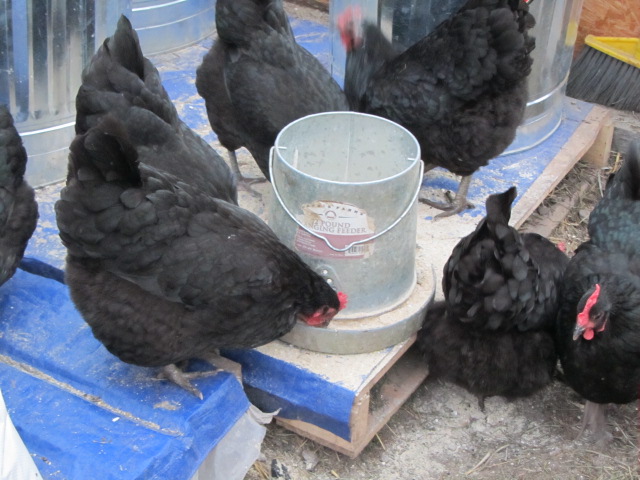
Figure 1. Black Australorps feeding
One distinct advantage of chickens (and many other fowls) is their ability to easily breed and brood eggs to make more laying hens. There are many devices that have been invented to incubate eggs to produce chicks. In the energy descent, especially during times of crisis, it may not be possible to incubate eggs with electrically powered equipment. Since it is fairly easy for chickens to produce and raise their own young, it is strongly advised that all small scale chicken raisers lean how to breed and brood their own chicks to ensure a sustainable supply of laying hens. Several good references for raising chickens from eggs have been published. One highly recommended book is Gail Damerow’s Storey’s Guide to Raising Chickens.[5]
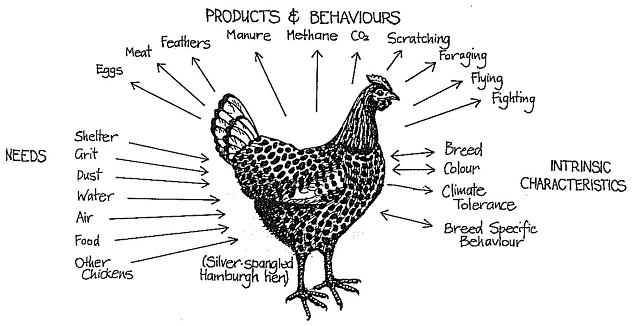
Figure 2. Selecting a breed (from [15])
Day-old chicks are widely available from many sources, local, regional, and national. They are going to be increasingly expensive in the future due to rising transportation costs and newer food security regulations. In a steep energy decline, the traditional regional and national sources may no longer be affordable or even available at all. We will need to depend upon home-brooding or smaller scale, local commercial brooding/incubation of chicks.
Housing options
Many beginning chicken owners have romantic notions of “free-range” chickens. Free-range chickens usually have at least a 50 percent loss rate due to predators. Also, the eggs of free-range chickens can be difficult to gather because they are often laid in hidden, inaccessible places, greatly reducing the useful yield of the flock. If you are dependent upon chickens and their eggs for a subsistence food base, “free-range” is not a good idea.
To maintain high levels of productivity and prevent predation, chickens must be watched over and, at a minimum, contained within a secure fence high enough to keep the chickens in the pen. An electrified fence powered by a small solar panel will prevent almost all small-animal predation. For an example of this type of fencing see [6]. These portable fencing systems, while not inexpensive, allow for frequent relocation of the fence to enable appropriate management of the areas being pastured. Netting the penned-in area may be needed to prevent predation from hawks. Chickens kept in fenced-in enclosures are said to be pasturing or “free-roaming,” but they are not free-ranging.
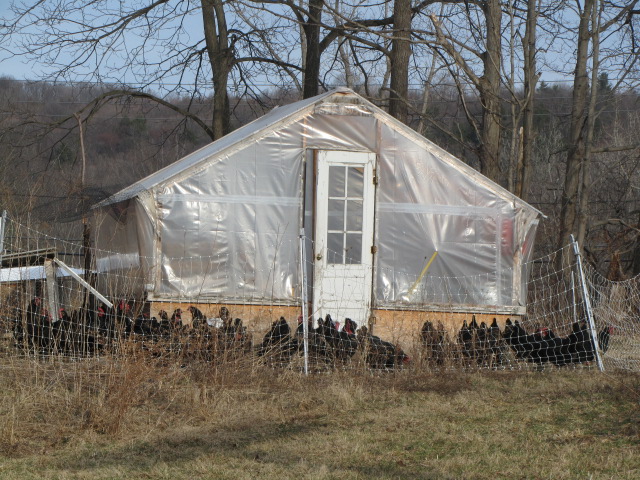
Figure 3. Chickens behind electro-net fencing
The construction and use of a secure chicken coop that is small-mammal proof is strongly recommended. Our chickens roost in their coop and are tightly closed in at night to prevent loss from predation and to provide shelter during bad weather, especially over the winter. Chicken coops can be made from a wide variety of materials, from hundreds of available designs. For examples, see [7].
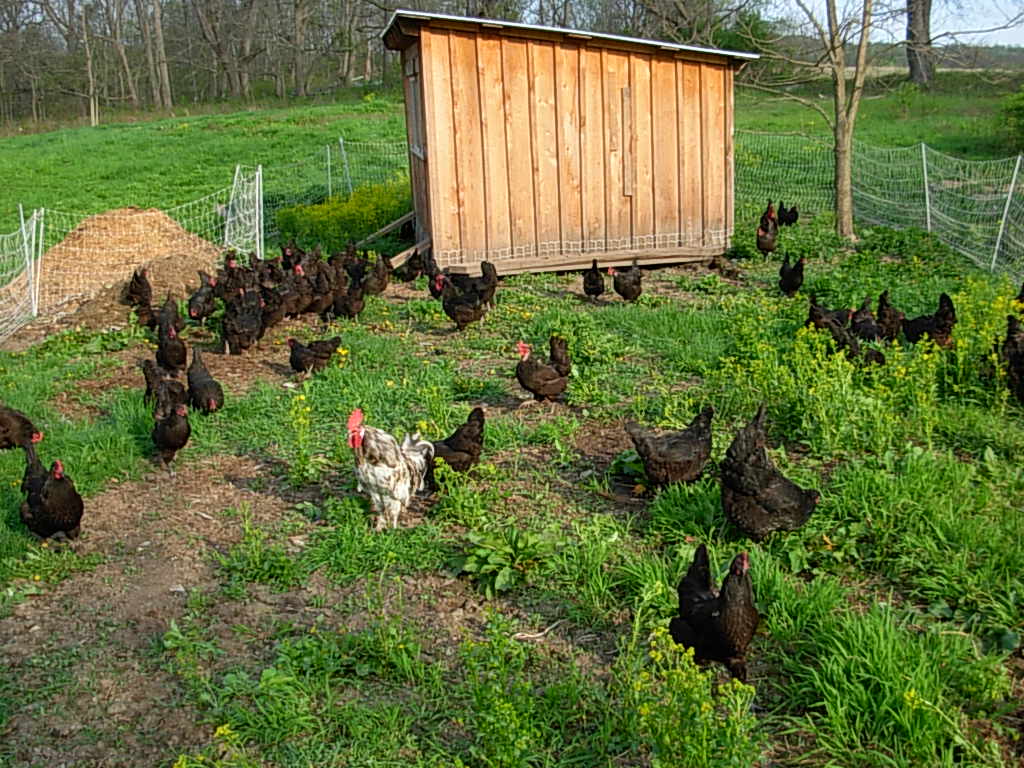
Figure 4. Chicken coop on skids
The use of chicken tractors is also very popular and greatly extends the functionality of having chickens while providing additional protection and security. A chicken tractor is a lightweight, moveable coop. Many designs are available, depending upon your use of the tractor and the number of chickens involved. Chicken Tractor, by Andy Lee and Pat Foreman,[8] gives extensive information on the construction and use of chicken tractors. Chicken tractors can be used to pasture chickens, with the tractor being moved to fresh grass as needed. If tightly constructed and installed, a chicken tractor will provide reasonable security against attacks by small predators. Our chicken tractors are a wood frame covered with chicken wire with a hinged piece of plastic sheet roofing material for a lid. The lid is normally hooked shut when the tractor is in use. Some people use small hoop houses for chicken tractors. You will see a wide variety of chicken tractors at [9].
The best use of the chicken tractor is to prepare an existing garden for planting. Six to ten chickens in one of our chicken tractors will eat everything organic down to the ground over a 4 x 8 foot area in 10 to 14 days, including all sorts of difficult-to-eradicate weeds and grasses. We then loosen up the area with a fork to remove the big roots of last years’ crops and weeds while mixing in the chicken manure and some additional compost. Other techniques are possible, such as working up a new garden plot or feeding specific home-grown crops to chickens.
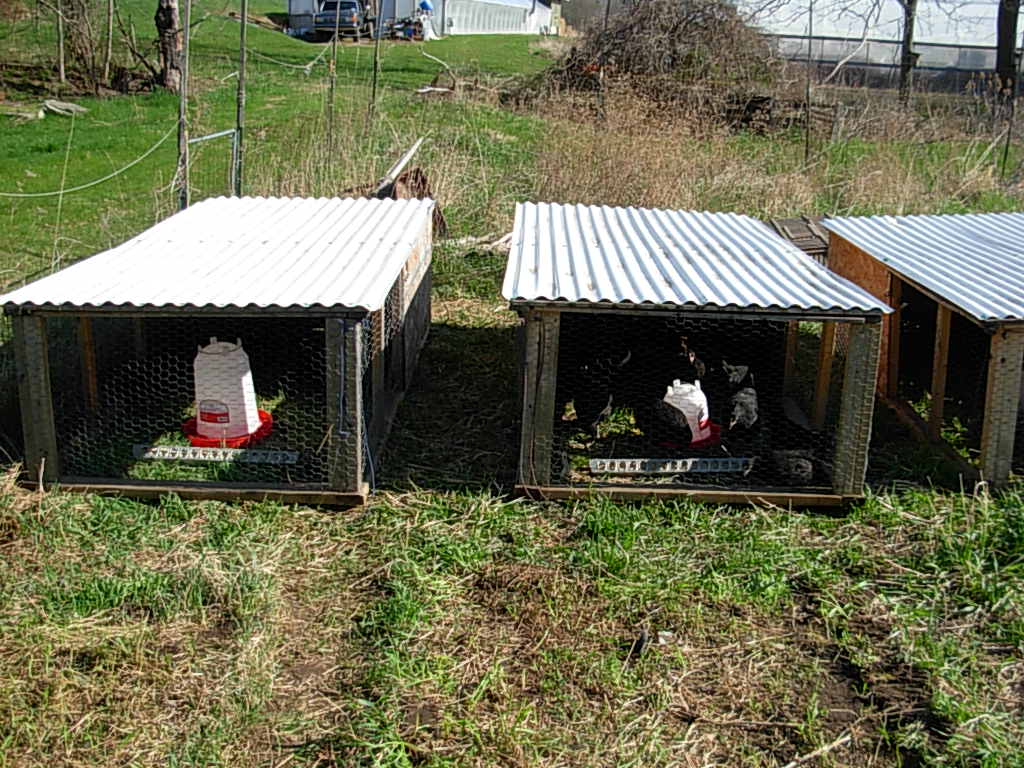
Figure 5. Chicken tractors in the garden
Food and Water
For many small-flock chicken owners, the cost of traditional grain- and soy-based feeds is 70 percent of the cost of the maintenance of their flock.[10] Commercial grain products used in chicken feeds consume vast amounts of fossil fuels in their production, processing, and distribution. Overall, agriculture contributes eight percent of the anthropogenic component of global warming gases. Even a modest rate of energy decline will have disproportional impacts on the cost of laying mash, pushing the price of chicken feed out of the range of feasibility for many small flock owners. This is already happening. A steep rate of decline would mean that nicely milled and amended layer mash in 40-pound bags may no longer be available at all.
Fortunately, for those who can develop a flexible and resilient approach to feeding chickens, many options to currently available commercial chicken feed are available. Chickens will eat almost anything, with some major exceptions (alliums and citrus in particular). If chickens are free-roaming and pastured and given a variety of supplementary foods, they will eat those foods that provide adequate nutrition. Many small flock owners feed mostly kitchen food scraps and some scratch feed (cracked corn or corn/wheat mix) and have healthy chickens and lots of great eggs. Owners of larger flocks cannot supply enough scraps to provide adequate nutrition, so they traditionally resort to commercially available feed mixes.
As the energy decline progresses, access to commercially available layer mash will be increasingly limited for the the small flock owner due to increased costs, limited access to some ingredients commonly used in commercial feed mixes, and other factors (the difficulty manufacturers may have in repairing or replacing equipment, for example). If land is available, many crops can be grown for chicken feed with low technology and few investments. Since chickens will eat everything from amaranth to zucchini,[11] there are many options, depending on the type of soil and the availability of water and nutrients (compost), seeds, labor inputs, etc. Carefully selected crops, most of which are human food crops as well, will allow for adequate nutrition for a flock of chickens over the seasons. Larger flocks are going to require large plots of land, with more grains and seeds to be grown and saved for the winter.[12]
Other local grain and feed options are readily available. For example, I have been purchasing “waste” grain products from Farmer Ground Flour in Trumansburg, New York. I mix supplements with the waste grain products and make a high-grade, organic layer mash. The carbon footprint of my homemade layer mash is significantly less than feed from other regional or national outlets. Other nearby grain mills have sold “seconds” or waste products to local farmers over the years for chickens and other farm animals. I anticipate that feed co-ops will develop to split up the rising costs of the components of feeds. Fish and crab meal, for example, are commonly used feed amendments. Being in the interior of the country, traditional sources of fish meal would be either very expensive or non-existent, depending upon the slope of the energy decline curve. Perhaps a local source of farmed fish for fish meal could be developed?
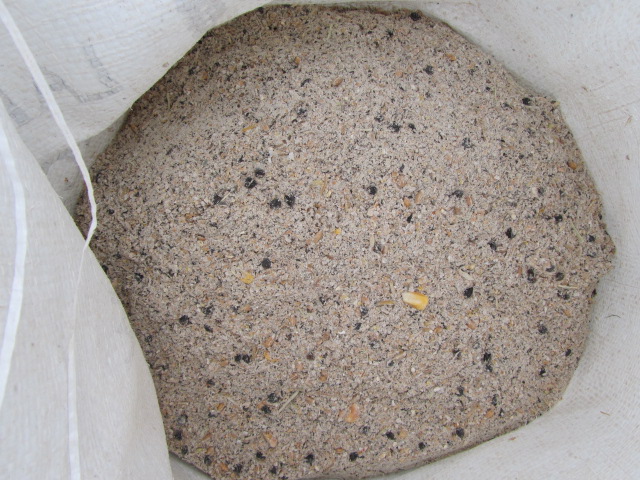
Figure 6. Locally made layer mash
Cooperative efforts to share resources for chicken feed would be very useful. Sharing bigger farming equipment, sharing saved seeds, and trading chicks to maintain diversity are examples. Chickens love milk, yogurt, and other dairy products. Apples, pumpkins, squash, and other fall veggies that store fairly well can be fed over the winter, providing diversity when pasture isn’t available. Waste vegetables from nearby farm stands can often be gleaned in the summer and fall, and they add value to the nutrient intake of your flock. Chickens love hay in the winter, and we have very local sources of organic alfalfa hay. Duckweed, which commonly grows on local ponds, is a highly nutritious chicken food (see the TCLocal article “Visioning County Food Production, Part 6” for more about duckweed in sustainable food production). Sprouted grains provide grass in the winter; I use oat grass, because oats are very inexpensive and germinate readily.
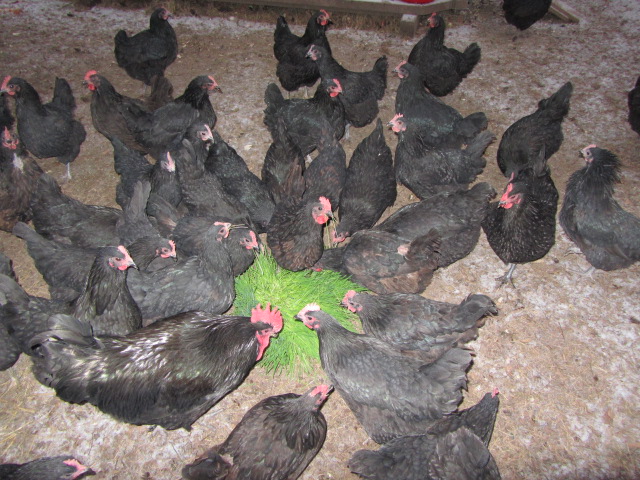
Figure 7. Chickens eating oat grass
Other options include feeding chickens active compost or certain insect larvae. Active compost has a high percentage of insects and other high-protein sources perfect for chickens. Some chicken farmers raise meal worms or black soldier fly larvae as chicken feed.[13] These techniques can significantly reduce the consumption and dependence upon grain-based feeds and their high fossil fuel inputs and large carbon footprint.
Chickens need a lot of water. Laying hens use up to two cups of water per day and even more in hot weather.[14] Water requirements are often higher in winter, when humidity is low and feeds and grasses are dry (hay, alfalfa cubes). The chickens’ water needs to be clean, potable water from a reliable source. Springs, wells, and urban water sources are all commonly used. In the early stages of energy decline, most of these sources will remain stable, although spare parts for pumps and wells may be hard to obtain at times. In a steep energy decline, energy sources and systems (delivery of public water supplies) will be disrupted or non-existent, parts will be impossible to obtain, and only secure natural sources (uncontaminated springs or wells) will allow for good quality water. Alternatives need to be developed. Clean rainwater catchment on a scale to water a modest flock is possible for most chicken owners.[15] The catchment and storage systems would need to be in place and functional when needed. Chickens can also drink from a clean stream or pond if one is available. Contamination from agricultural runoff, especially if you are raising organic chickens, and from animal wastes is of serious concern when using a stream or pond as a water source.
Other requirements for chickens are oyster shell and grit. Layer hens have a high calcium uptake, and the general recommendation, based on information from Lakeview Organic Grain, is 127 pounds of crushed oyster shell per ton of feed. The grit, needed to grind food internally, is most frequently sold as ground granite. Grit is free-fed; in a free-range or free-roaming situation most chickens will find all of the grit they need outside. Grit is most often fed in winter, when snow cover and frozen ground prevent normal foraging. Oyster shell will be more problematic, especially in a steep energy decline, and alternative materials and sources need to be found. Ground up egg shells provide one option, but this is a limited source.
Flock management
Many management issues will be affected by energy descent. Moving a coop from pasture to pasture is easy if you have an appropriately sized tractor and the fuel to run the tractor. If not, do you have a neighbor who owns a horse who will help you every two weeks or so? Some may elect to have their own horse; perhaps several nearby farms could share a horse and the expense of maintaining the horse. Building a coop with wheels would facilitate movement, perhaps only requiring a few strong people.
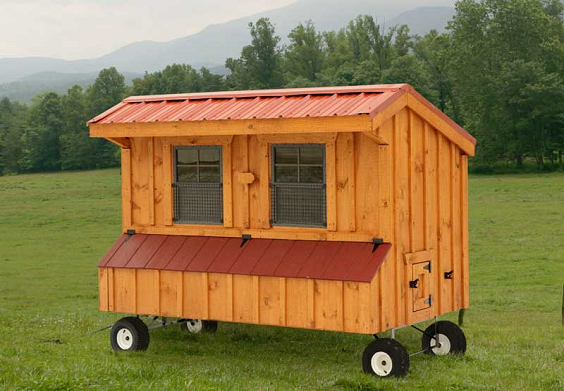
Figure 8. Coop on wheels
As the energy descent progresses and liquid fuels become more expensive, different business models will quickly evolve. We now deliver most of our eggs to our CSA customers. Perhaps there could be a central pickup point arranged for several customers in one area so as to save on fuel costs. Feed co-ops will develop to split up the rising costs of the components of feeds. Joint ownership of expensive equipment will enable a number of farms to thrive.
As eggs become an increasingly valuable component of our diets, food security issues become more important. There are well-established protocols for the handing of birds and eggs that reduce the possibility of contamination and disease transmission.[16] This is an area that is often poorly understood by small-flock owners.
Keeping chickens cool in summer and warm in winter is important. The use of solar heating and solar PV for other equipment will become increasingly important. If global warming increases at the rates projected, it may be necessary to change the breeds or varieties of chickens and other fowl to those that tolerate heat better than traditional breeds.
Attention to manure management will be especially important. Chicken manure is very rich in nitrogen and other nutrients. It may be composted or mixed directly into the soil. The appropriate rotation of fertilized pastured areas, gardens, and grain plots can maximize the inputs of chickens to the nutrient cycle. In a steep energy descent, most or all of our resources will come from the farm itself.
The management of breeding stock, the culling of poor producers, and other hands-on management issues will need to be addressed to maximize the long-term success of the flock. Health issues will may be more of an issue, especially in a steep energy descent. Our chicks come from Missouri, arriving with vaccinations for several diseases. Where would these vaccinations come from in the future? Very few vets know about chickens. Last year New York State defunded the state veterinarian position that has served the poultry industry in New York for several decades, so there is only thin support of flock health available going into the near future. How are we going to learn to be our own vets as far as our flock health is concerned? There are many challenges ahead.
Conclusion
Readers of this article may not live to see the hard times ahead, but their grandchildren certainly will. Chickens and other fowl will be an integral component of a resilient community as we enter an uncertain future.
References
[1] Deppe, Carol. The Resilient Gardener. Chelsea Green Publishing, 2010, p. 178.
[2] See the TCLocal series of articles on local food production by Karl North, beginning with “Visioning County Food Production—Part One: Introduction” (http://tclocal.org/2009/07/visioning_county_food_producti.html).
[3] See, for example, http://139.78.104.1/breeds/poultry/, from Oklahoma State University.
[4] See, for example, http://www.mypetchicken.com/chicken-breeds/which-breed-is-right-for-me.aspx.
[5] Damerow, Gail. Storey’s Guide to Raising Chickens. Storey Publishing, 1995. For additional general information see http://www.backyardchickens.com/lcenter.html and http://www.lionsgrip.com/pastured.html; Small-scale Poultry Keeping by Ray Feltwell (Faber and Faber, 1992); and the periodical Backyard Poultry (http://www.backyardpoultrymag.com).
[6] http://www.premier1supplies.com/c/poultry_supplies/electric_netting/
[7] http://www.freewoodworkingplan.com/index.php?cat=212. Sometimes the home page works better: http://freewoodworkingplan.com/.
[8] Good Earth Publications, 2006.
[9] http://home.centurytel.net/thecitychicken/tractors.html
[10] Storey’s Guide to Raising Chickens, p. 53.
[11] For example, http://steephollowfarm.wordpress.com/2009/06/18/chickens-like-a-lot-of-things/. See “Local Notes on Chicken Feed” (http://tclocal.org/docs/chicken-feed.pdf) for some ideas about local possibilities.
[12] See Logsdon, Gene, Small-Scale Grain Raising (Chelsea Green Publishing, 2009).
[13] See http://www.sialis.org/raisingmealworms.htm#timetable and http://blacksoldierflyblog.com/.
[14] Storey’s Guide to Raising Chickens, p. 60.
[15] See, for example, Mollison, Bill, Permaculture—A Designers’ Manual, 2nd ed. (Tagari Publications, 2004), pp. 165-170. A detailed overview of rainwater catchment techniques developed in third-world countries can be found in Gould, John and Erik Nissen-Petersen, Rainwater Catchment Systems for Domestic Supply (ITDG Publishing, 1999).
[16] http://www.eggsafety.org/producers/food-safety-regulations
Categories
agriculture , food4 Comments

GREAT article- I'm posting a link on our TRansition website, in our chicken group "The Flock". Keep up the good work!
Kate
Tom,
Interesting article but the focus seems to be on rasing chickens in a rural or large-lot suburban context. Raising chickens in an urban and village context can be found throughout the world outside the US, and in a few small towns that have not adopted the zoning prohibitions on such use typically found in this country.
We need to think of urban poultry raising, if only because the notion of living in the country and commuting miles to work each day that is so popular in this country is not likely to survive the energy descent.
George Frantz
"... ducks are an important contributor to the small farm environment, but well-managed chickens are a better fit as an integrated component of a sustainable farming system."
Hmmm... you can let your ducks and geese into your garden, and they'll suck up the slugs and eat invading grasses, while leaving broad-leaved plants (the veggies you're growing) alone.
If you let your chickens into your garden, they'll tear up your beds and eat most of the plants you want to keep! We lost most of our strawberry plants when the chickens got loose.
Also with a reasonable pond, ducks can live off forage better than chickens do. And ducks are more fun, too -- they're right there next to me while I'm weeding, going after the grubs as I loosen the soil!
So I was sorry to see a "better" stuck in there. They're ALL part of an integrated system! Chickens and ducks have fundamentally different needs and benefits. And don't get me started on the importance of goats!
just as an aside
those of us living along the great lakes (esp Lake Erie) can substitute oyster shell for zebra muscle shell
right now that stuff is available by the bucket load along undeveloped stretches of the lake
be careful though, it's razor sharp and should be pulverized at least a little bit before you feed it to your birds
cheers